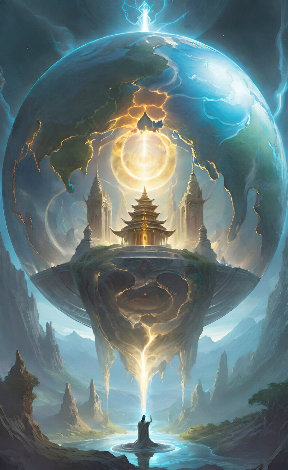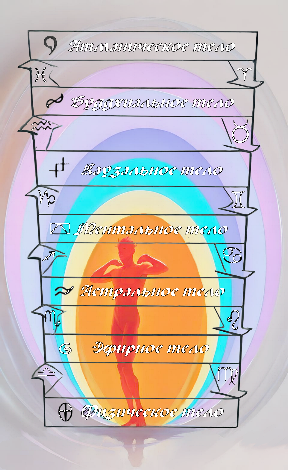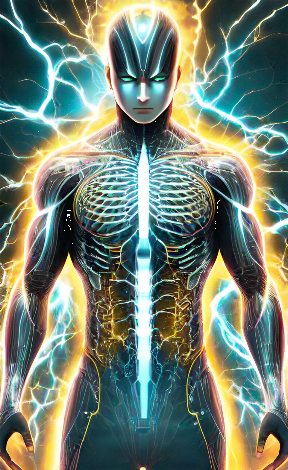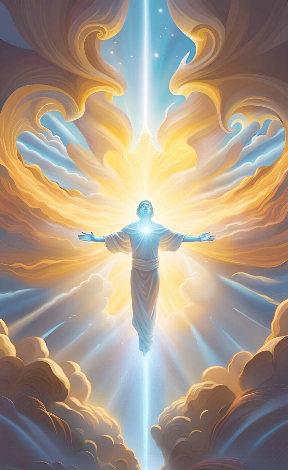The Secret Hidden Behind Matter. Introduction
Below, we offer the reader a specific way of perceiving and seeing the world, both dense and subtle. The film "The Secret Hidden Behind Matter" on YouTube confirms and scientifically substantiates the reality of other worlds described by us and methods of consciousness control.
Texts marked in blue are the result of the joint creativity of the website author and Artificial Intelligence. By clicking on the images, you will access an additional gallery of pictures with supplementary descriptions.
Introduction to the World of the Mysterious Beyond the Material
Dear reader, we invite you to immerse yourself in a world of mystery, hidden and as yet boundless. This world is far more interesting, powerful, and real than most people might imagine. A clairvoyant, when observing the aura of another person (non-human, animal, etc.), sees captivating energetic movements, structures, forms, and colors that manifest within and around the physical body. These manifestations are not seen with physical eyes, as some might think, but with the help of the pineal gland — our "Third Eye"The pineal gland is located in the center of our brain and allows human consciousness to transition from our four-dimensional reality into the otherworldly. It is the most energy-intensive organ in humans. During its activation, the pineal gland gathers up to 30% of all energy, creating an impenetrable swirling energy field of protection around itself. This is necessary to ensure normal operation so that it is not affected by external force influences.
Inside, the pineal gland is filled with a special structured water, which is an excellent accumulator and keeper of information. The inner walls of the gland have a structure similar to our eyes, with retinas and cones. Nerve trunks emerge from the pineal gland in two directions: forward between the eyebrows and into the area where the spine connects to the skull. This structure is what we call the "Third Eye."
Furthermore, the pineal gland is responsible for our dreams and the world we see in them..
This energetic structure primarily consists of two components and plays a key role in our interaction with the surrounding world and our internal state. These are:
- Energy bodies, which represent centers of spaces and a personal out-of-body spacesuit of the body-soul within them;
- Energy channels, serving as centers of transitions between these spaces and spacesuits.
Some readers may wonder why new, previously unknown words and expressions, long sentences laden with deep meaning, etc., are offered for their consideration. To this, I would like to say the following immediately.
One of the most important sciences in the world is linguistics; it just hasn't realized it yet. There is nothing more important than language, for it is the link between man and the subtle world. In processes such as learning, creativity, thinking, and feeling, the language in which our subconscious communicates with us — primarily the most frequently used words in thought or speech — largely determines the course and outcome of these processes. And even the external presentation of the results of any activity plays a fundamental role: subtle moments, for the sake of which the "garden is fenced," can only be conveyed in an adequate language, and any attempts to express them in a cruder dialect invariably fail. Many volumes of philosophical, scientific, and artistic works are overflowing with the desire to convey a thought or sensation without finding the appropriate language, to the great detriment of humanity eager to understand.
The use of language, whether positive formulations or crude expressions, significantly influences our perception of reality and thinking. People who prefer positive language often perceive the world more joyfully and openly; phrases like "I can do this" instead of "I can't" contribute to more constructive thinking and increase self-confidence. Conversely, frequent use of profanity limits vocabulary, which greatly narrows the horizons of thought. If one must use profanity, it should be done timely, at the right moment, and in the appropriate context — on the Battlefield (in a verbal fight), where it can be beneficial.
Otherwise, profanity replaces many words with primitive expressions, leading to "gluing" the mental plane and reducing cognitive flexibility. As a result, the ability to perceive and analyze the surrounding world can noticeably deteriorate, which emphasizes the importance not only of choosing words that enrich our inner space and contribute to a deeper understanding of life, but also of the thoughts we form with their help.
From my side, I want to warn the reader if they discover any contradictions and disagreements with previously known information about the number of chakras and bodies in a person. Oris states that there are 12 chakrasThe Collective Consciousness of the Chakra Personality (Soul Aspect) – one of the 144 main types of realization Forms of Cosmic Creativity Aspects – In total there can be 144 souls, possibly one or more of which will be our shells (bodies) after death. This depends on which of the 144 souls a person paid the most attention to throughout their life., which can be viewed at different levels. However, many of these levels have similar characteristics, and for ease of understanding and practice, they are often combined into categories that are simpler to perceive. In the works of Oris, as well as in the books of Avesalom Podvodny, these levels and their unique aspects are described in detail, allowing the reader to understand more deeply the structure of chakras and their influence on human energy.
Channels (Chakras) and Subtle Bodies
The human bodies are connected to each other by various channels, the main ones being the chakras. Functionally, chakras are designed to transmit various information-energy flows through a person: from an egregor to the external world and back. Each chakra is capable of passing a very wide spectrum of flows, both high and low, and accordingly, has its projections on each of the seven main subtle "physical" bodies. Thus, if bodies are imagined as being arranged horizontally, each on its own frequency band of characteristic vibrations, then chakras are, on the contrary, vertical channels, each passing through every body, but having a specific vibration, i.e., a characteristic overtone for the chakra, which is felt on each body, but slightly differently.
A person has seven generally known and thoroughly researched bodies: physical, etheric, astral, etc., of which only the physical is observable. Let's consider for now only the astral body, which is responsible for the psyche and emotional life and belongs to the subtle bodies, i.e., to the subtle world. Let's imagine that a person's astral body became ill, say, depression began. Due to depression, the tone of protective forces decreased, and a pathogenic microbe, always present in some quantity in the body, multiplied uncontrollably.
Another example: A person fell ill with pneumonia. In this case, the last material cause of the illness was insufficient activity of lymphocytes. The reason for the drop in this activity was already in the illness of the astral (subtle) body. Of course, both microbes and lymphocytes of the physical world have correspondences (analogues) in the subtle world, between which certain laws of interaction exist (more details in the topic Diseases of the Seven Bodies).
The strongest information-energy connections exist between adjacent bodies, for example, physical and etheric, or between etheric and astral: however, some connections exist between any pair of bodies, even between physical and atmanic, but the further the bodies are from each other, the thinner the communication channels between them, and activating them is possible only in exceptional cases (spiritual healing). Nevertheless, direct connections between bodies, such as physical and astral, as well as etheric and mental, are quite strong and can be consciously controlled: this, in particular, is taught by some yoga techniques. For complete understanding, it should be added that each zodiac sign corresponds to its dominant (favorite) meditation of information-energy exchange between bodies (figure on the left).
From the perspective of the karmic egregor, the main work of a person is their daily life, and the primary tools given to them for help are all their bodies: physical, etheric, astral, mental, causal, buddhic, and atmanic. There are various (vertical) connections between these bodies, but they still live, so to speak, their own lives, meaning they are largely autonomous, and are often out of sync, which a person experiences with great difficulty.
Generally, the science of man as a single whole did not exist, but the point has been reached. In the written book Ark of the Covenant, approximately 300 pages with illustrations from AI, a complete description of the main structure of the Universe is presented. This work became the first step towards creating a science of the unified whole. This website presents more than modest information about the structure, functions, and interrelationship of subtle bodies, which complement the content of the book and help to better understand the presented concepts. So the author asks the reader to perceive the descriptions provided below (which are undoubtedly incomplete and may contain minimal errors) as the first impressions of a traveler who has circled the globe in twenty days, but not as a detailed geographical atlas.
Therefore, for general understanding, we provide only an operational description of the bodies, i.e., defining situations when the corresponding body is extremely accentuated.
Brief Description of Human Bodies
The Physical Body is the subject of study for doctors, physical education teachers, sports coaches, Hatha yogis, nutrition specialists, and healthy lifestyle proponents.
The Etheric Body is the energetic matrix upon which the physical body is built, for example, how a child grows or a wound heals. The crudest human energy is associated with the etheric body, normalized (or disturbed) by food, interaction with elements, and sexual relationships. The state of the etheric body determines a person's vitality and immunity; it is the focus of doctors after a successful operation or a patient's crisis has passed – its state directly depends on the speed of physical body healing and its ability to fight infection – external or internal. A person with a strong etheric body exudes health, can easily tolerate cold, and will plunge into an ice hole without much effort. Conversely, a person with a weak etheric body gives the impression of being withdrawn, neglected, and generally unhappy. Instinctively, one wants to warm them, feed them, give them shelter for the night, and some money for their future life.
The Astral Body is associated with the emotional sphere of human life. Love, hatred, sensuality, and any other emotions overwhelming a person are indicators of the active life of the astral body, which is generally much more mobile than the etheric (correspondingly, the mental body is more mobile than the astral, and so on). A person with a strong astral body easily excites those around them, eliciting various emotions (often not exactly what they intend), and is even more easily excited themselves. However, one should not think that the energies of the astral body can feed the etheric. This is not the case. Even the most fervent and emotional expressions of sympathy for a physically hungry person help little. A person with a strong but uncontrolled, so to speak, uncultured astral body evokes mixed feelings, even when on a theatrical stage. In everyday life, they are often intolerable. Although, on the other hand, they can serve as a source of energy for various vampires who feed on the energy of other people's emotions.
The latter category often includes people with a poorly developed astral body. They give the impression of being cold, indifferent, and impenetrable. Indeed, strong emotional experiences are rare for them, let alone superficial empathy, which, however, does not in itself imply a low moral or spiritual level. The fact is that the astral body is associated precisely with superficial emotions. This is, for example, infatuation, but not exalted or deep love, which are vibrations of higher bodies.
The Mental Body is associated with reason, intellect in the usual (combinatorial) sense of the word and, accordingly, with a person's mental picture of the world. The entire 20th-century civilization primarily appeals to a person's mental body. This body is nurtured and trained from infancy until death: "Be reasonable," "act this way and that way because of this and that." A person with a weak mental body has nothing to do in modern society: "You'd better not have been born into this world at all!" – the collective subconscious condescendingly and encouragingly tells them – "So, better listen and literally do what the smart grown-ups tell you."
Conversely, a person with a strong mental body, even if not particularly flexible, feels good and comfortable in society. They can easily overwhelm an interlocutor with their arguments and reasoning, using them not as a tool for understanding the world, but as a weapon, and are often very pleased with themselves afterwards. However, a strong mental body specifically means the ability to combine various considerations. It does not provide opportunities for upward movement. Its functions are somewhat different. They are rather characterized by the concepts of "comprehension," "construction," and "management."
The Causal Body is of particular interest to fortune-tellers, as it encrypts a person's dense karma – specific events of their external life and distinct internal experiences. When the "seal of death" sometimes appears on a person's face, it means that the one seeing this "seal" has actually observed and interpreted the corresponding sign on the causal body. The causal body is sometimes very active and expressive. And then, regarding this person, those around them experience all sorts of premonitions, sensations of future events, and so on. A person with a strong causal body is a treat for a psychoanalyst, as they largely live under the influence of specific events from their past, by uncovering which and bringing them into consciousness along with their subconscious interpretation, the analyst can correct and normalize energetic flows, directing them into their natural course. They might say, for example: – "Free the libido from the oppression of infantile fixation." Conversely, a person with a weak causal body practically never has premonitions, prophetic dreams, and the like. But on the other hand, they are weakly connected to their past, which does not pursue them with long, heavy tails, but, on the contrary, is quickly forgotten in the flow of current events, which, however, is also perceived by the person as not too significant, no matter how strongly events are accentuated in their mental or astral bodies.
One should always distinguish between a strong body and a strong body controlled by human will and consciousness. For example, in this case, a strong but poorly controlled causal body produces a person of the witch-fortune-teller or sorcerer-manipulator type, around whom "something" constantly happens (i.e., flows of dense karma swirl) and who undoubtedly influence other people's destinies, but the nature of this influence and its results are not always controlled by them, especially concerning themselves personally. A strong, controlled causal body gives a mage-priest or a clergyman. Such people clearly foresee the immediate future of the dense plane and influence it directly, but within reasonable limits. That is, without leading to a strong disturbance of the dense karmic flow. However, the weakness of the causal body (and, accordingly, poor vision of dense karma) does not always mean low realization power or low spirituality — some mages work at the next level.
The Buddhic Body contains information related to subtle karma, i.e., the main plots according to which dense events unfold. The Buddhic body is of primary interest to educators, spiritual mentors, and psychologists who seek to change fundamental psychic structures in a person and corresponding life plots, closely related to their main life positions, ethics, and specific ways of perceiving the world.
Around a person with a strong Buddhic body, a characteristic existential-psychological tension arises, in which those around them lose their usual defenses and begin to speak sincerely about what concerns them most, but they do not discuss specific events and problems (causal body), but rather their psychological difficulties, questionable life positions, problems of their general development, and so on – in short, everything that can be called the methodology of the life path – external and internal. Encounters with such a person can strongly change one's life, but the upheaval preceding such a change will be significant and, most likely, will be accompanied by a strong change in character and worldview. However, people with a strong Buddhic body most often attract those already in a state of deep crisis. Whether they help them get out of it or exacerbate it depends on the level of mastery of this body, which is impossible without the direct help of a high egregor. Such a person can clearly see subtle karma, and the psychological background of those around them is usually clear as day – everything, except their specific spiritual problems.
Conversely, a person with a weak Buddhic body absolutely does not understand why there is so much fuss around all this psychology, which for them is like reading tea leaves for a seasoned atheist. Their life positions are not particularly significant to them, and they do not feel that their life on the dense plane is the materialization (embodiment) of certain plots that hold fateful power over them, but from which they still wish to escape by some miracle. Their character does not bother them, and they do not feel its power over themselves and their circumstances, nor the necessity to change something in themselves and their worldview. The character of those around them and the future plots of their lives are poorly visible to them, but again, this is not always a sign of a low spiritual level.
The Atmanic Body is the shell of the higher "I," Atman, or the Absolute in a person. The atmanic body encrypts the mission, or the main goal of a person in this life, which determines (within the surrounding reality – subtle and dense) the main plots recorded in the Buddhic body. The atmanic body is associated with a person's highest ideals and fundamental religious and abstract-philosophical life positions, their unique way of communicating with God (religiosity in the most intimate sense of the word) and their own distinctive worldview, i.e., their way of perceiving the world as a whole.
A person with a strong atmanic body distinctly (at least for themselves, but often for others as well) feels within themselves a divine spark, or their direct connection with God, and it is in this connection that they see the main content of their life. At a high level, they strive to introduce their flock to their God (more precisely, to the channel of communication with Him). For such a person, it is incomprehensible how one can live without God and strive for anything other than Him. However, the connection with the Absolute can be realized in different ways, for example, through religiously understood love, knowledge, work, and so on. And then such a person pronounces these words, as it were, with a capital letter. Generally speaking, a strong atmanic body does not necessarily mean spiritual development. If it is uncontrolled, a person may chaotically rush through religious currents, talk only about God or sufficiently sublime matters, but bring only chaos, fanaticism, and profanation of the religious idea into the world. However, conscious control of the atmanic body is only partially achievable and requires direct assistance from a karmic egregor. Only then can a person become a true spiritual teacher.
The weakness of the atmanic body leads to indifference towards religion, at least in a consciously perceived human form: prayers, high meditations, and conversations on abstract-religious-philosophical topics are unlikely to attract them for long, and what other people actually do in church is not always clear to them (excluding moments of begging). However, even such a person should not be accused of being unspiritual. Spirituality means following one's personal evolutionary program, determined by the person's karmic egregor. And this program may well involve working predominantly with one or two bodies, while the others are assumed to be dormant. And sometimes very high souls with an extremely responsible program are incarnated with artificially subdued higher bodies. For them, this incarnation is like descending into hell, where they are given a very specific task in their inner reality, which may not be directly related to spirituality but, nevertheless, plays an important role in human evolution.







